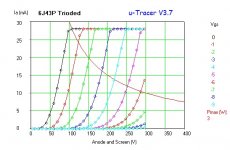Yea, I’m abusing mine definitely. I’m running the dissipation at 5w and 230v plate. I wouldn’t build it for someone else like that but for me I’ll see what happens. The plates aren’t red and I’ve been running it all day for a few days now.
Tell me did you need the gain of a 600:15k Transformer, or do you think id get by using a 10k:10k for DAC sourced music? I have some some Jensen 10k:10k mu-metal inputs and all the other parts already.
Congrats! A very nice design and beautifully crafted with love. Some questions as I am curious:
1. Would distortion be significantly lower with better iron (and the matched tubes as you wrote)?
2. How do you control volume? A semiconductor based buffer with source selector/volume control I guess?
1. Would distortion be significantly lower with better iron (and the matched tubes as you wrote)?
2. How do you control volume? A semiconductor based buffer with source selector/volume control I guess?
Last edited:
Yes, I think distortion in a circuit like this(no FB) specifically 2nd order can be lower with well matched tubes. The input transformers are fairly low distortion and don’t contribute much. The output transformers will be negatively affected by DC offset in the core so that’s also related to tube matching.
The circuit needs a low Z source and so passive volume control is out. Any sort of preamp or DAC with a buffered output will work fine. I’m using a miniDSP. I also have a FocusRight Scarlet Solo that has a volume control that works well. Both those devices have output Z in the 500R range. A tube based pre with CF output would also be fine.
After listening for a few days I can say it’s a nice sounding circuit. More bass than expected and pretty natural.
The circuit needs a low Z source and so passive volume control is out. Any sort of preamp or DAC with a buffered output will work fine. I’m using a miniDSP. I also have a FocusRight Scarlet Solo that has a volume control that works well. Both those devices have output Z in the 500R range. A tube based pre with CF output would also be fine.
After listening for a few days I can say it’s a nice sounding circuit. More bass than expected and pretty natural.
Last edited:
Thank you, I already expected this but for me that is no issue. I have some good quality iron but only 6k6 primaries .... bummer.
I take the power amplifier does not need any extra gain with modern sources? Then a source selector, volume control followed by a semiconductor buffer with enough drive capability seems most appropriate when one has more than 1 source.
A tube based pre with CF output would also be fine.
I take the power amplifier does not need any extra gain with modern sources? Then a source selector, volume control followed by a semiconductor buffer with enough drive capability seems most appropriate when one has more than 1 source.
Last edited:
Thank you, I already expected this but for me that is no issue. I have some good quality iron but only 6k6 primaries .... bummer.
I take the power amplifier does not need any extra gain with modern sources? Then a source selector, volume control followed by a semiconductor buffer with enough drive capability seems most appropriate when one has more than 1 source.
My build needs 1.3vrms in to clip the output so any modern source that can provide 2vrms will be fine. There’s not actually a huge difference practically between a 6.6k and 8k OT in the real world. Might work fine.
Very nice. How did you determine 150k for the two load/grid resistors? I was thinking of doing something similar with some 10k:10k bridging transformers.
Very nice. How did you determine 150k for the two load/grid resistors? I was thinking of doing something similar with some 10k:10k bridging transformers.
With transformers and specifically small signal transformers I go by experimentation. Different types are all very different. Some are super sensitive to secondary loading others are very sensitive to the driving impedance. Are usually take a low z square wave generator, something sub 100R. Then I put a pot in series with the primary, like a 1k. The. I load the secondary with a pot, like a 200k or something. Then scope the secondary and adjust the pots for the best FR. These Ampex units actually don’t care much about secondary loading but ring a bit up at 30k if the source Z is too low.
Great DIY production. Like this simple and straightforward circuit.Is it also very good to replace 6J43P with 6J52P?
I think my earlier posts were misinterpreted.
I mentioned the Randall amplifier, an EL34 that had both g2, and g3 tied to the plate.
I tried that, but did not find any advantage of that, versus g2 to plate and g3 to cathode.
The schematic in Post # 1 seems more correct.
g2 tied to plate, g3 tied to cathode.
Just my experience.
I mentioned the Randall amplifier, an EL34 that had both g2, and g3 tied to the plate.
I tried that, but did not find any advantage of that, versus g2 to plate and g3 to cathode.
The schematic in Post # 1 seems more correct.
g2 tied to plate, g3 tied to cathode.
Just my experience.
- Home
- Amplifiers
- Tubes / Valves
- 6J43P, single stage, transformer coupled, push pull, 3w amp.
